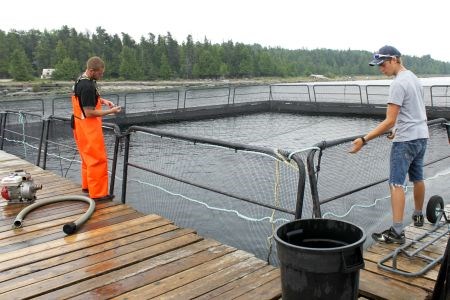“Have you ever heard, when ice is breaking up, that distinctive tinkling sound?” asked Mike Meeker as he surveyed the water surrounding his Evansville-based cage culture fish farm. “It's really pretty—it sounds like chimes—unless you know what it means, which is potentially big trouble.”
Ten years ago it was that tinkling sound that prompted the Manitoulin Island aquaculture guru to modify his cages to withstand the force of winter ice on Lake Wolsey, which had too often ripped apart his operation and those of his fellow Lake Huron fish farmers.
His solution? A submergible cage system that operates around the principle of positive buoyancy. After adding a top net to prevent fish escape and filling a series of floats with water, the entire 16-cage system can be submerged three to four feet under water in about 20 to 30 minutes and remain there for up to 28 days without damage or loss of fish.
His ingenuity earned Meeker a Premier's Award for Agri-Food Innovation Excellence this past spring—the second in four years. In 2008 he was lauded for the development of an organic compost comprised of fish offal and waste sawdust from Manitoulin sawmills.
In business since 1986, Meeker was the first cage culture producer on Manitoulin, but has since been joined by eight additional farms. Together, they produce thousands of pounds of fish annually and generate an economic impact of $65 million.
The process actually begins in southern Ontario, where fish fry are grown to fingerling size at commercial hatcheries before being shipped North.
At North Wind Fisheries on the Wabano Channel (a smaller tributary of the North Channel), operator Dan Glofcheskie has been fish farming since 1992, when he took his experience working for the Ministry of Natural Resources and applied it to his own farm.
Accessible via private land on Great LaCloche Island (land agreements are in place for its use), North Wind operates eight pens that generate 500,000 pounds of rainbow trout a year. Fingerlings are given 18 to 26 months to grow to market size, roughly 2.5 pounds, before being sent for processing. Fresh fillets are then sent across Canada and into the United States.
Describing his job as a cross between a farmer and a fisherman, Glofcheskie said the aquaculture industry is creating much-needed jobs in rural areas.
“We're providing employment and a means of making a living not only for my family, but also we employ three full-time people,” he said.
On Manitoulin, the industry has created 260 full-time jobs. But the Strategy for Sustainable Aquaculture Development in Ontario, commissioned in 2009 by the Northern Ontario Aquaculture Association (NOAA), the industry's governing body in the North, calls for growth of 10 per cent per year over 10 years, the result of which is expected to be 650 jobs in the North and an economic impact of $110 million.
The NOAA is now in the process of implementing that strategy, but it's been slow work, due, in large part, because of a lack of direction from the government, NOAA executive director Karen Tracey said.
Eighty-five per cent of Ontario trout on the market is grown in net-pen operations, but it still isn't meeting market demand. Tracey estimated the industry could easily be producing twice as much fish, but right now fish is being imported from countries like Peru and Chile.
“The big push right now is to get the political will to move this industry forward, to set up proper regulations, with environmental responsibility, of course, being at the forefront, but also trying to balance the costs and benefits with the economic contributions,” she said.
Farmers, meanwhile, continue to work on innovative advancements to streamline their work and enhance fish production.
At North Wind, Glofcheskie is using a fish pumping system—the only one in Ontario—to make harvesting easier. While his workers still use the traditional dip netting method, in the warmer months they employ a fish vacuum to gently suck up the fish into tanks and deliver them into transport totes, all without harming or stressing the fish.
“We're just trying to make things a little less labour intensive, a little bit more mechanical, and thereby reduce the wear and tear and back work that our staff has to do,” Glofcheskie explained.
At Meeker's Aquaculture, the fish farmer is involved in a number of research projects. He's started to add corn gluten to his fish meal to reduce cost and the fishy taste that is unpalatable to some consumers. And he's working on an offshoot of his award-winning compost program, developing a new system to harvest the gas produced during decomposition and use it as green energy.
“It's not going to change the product,” Meeker said. “It's just going to add another step which creates green energy.”
The NOAA also continues to work on a number of initiatives. It's currently in the process of certifying its producers as organic and envisions developing eco-tours to the farms. Tracey foresees growing new species and is working with the Department of Fisheries and Oceans on developing criteria for future farm site selection. The main focus, though, is increasing production.
“Right now, we haven't exhausted all the rainbow trout market,” Tracey said. “It's ready, waiting for us to grow more trout, so that's what we've been focusing on. The other will come as the economies of scale grow and the industry gets larger, and then the opportunity to diversify a little bit more.”




